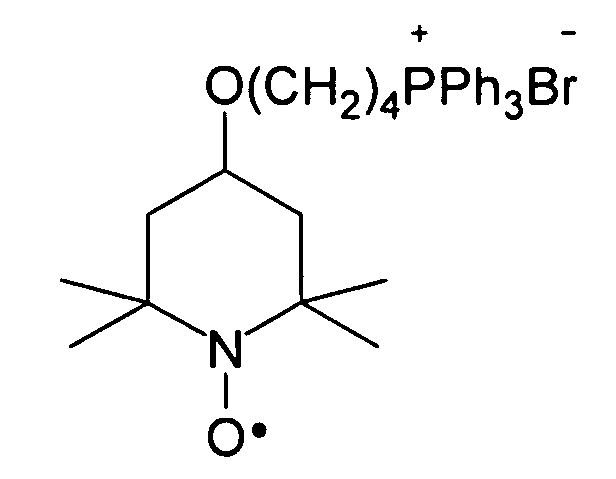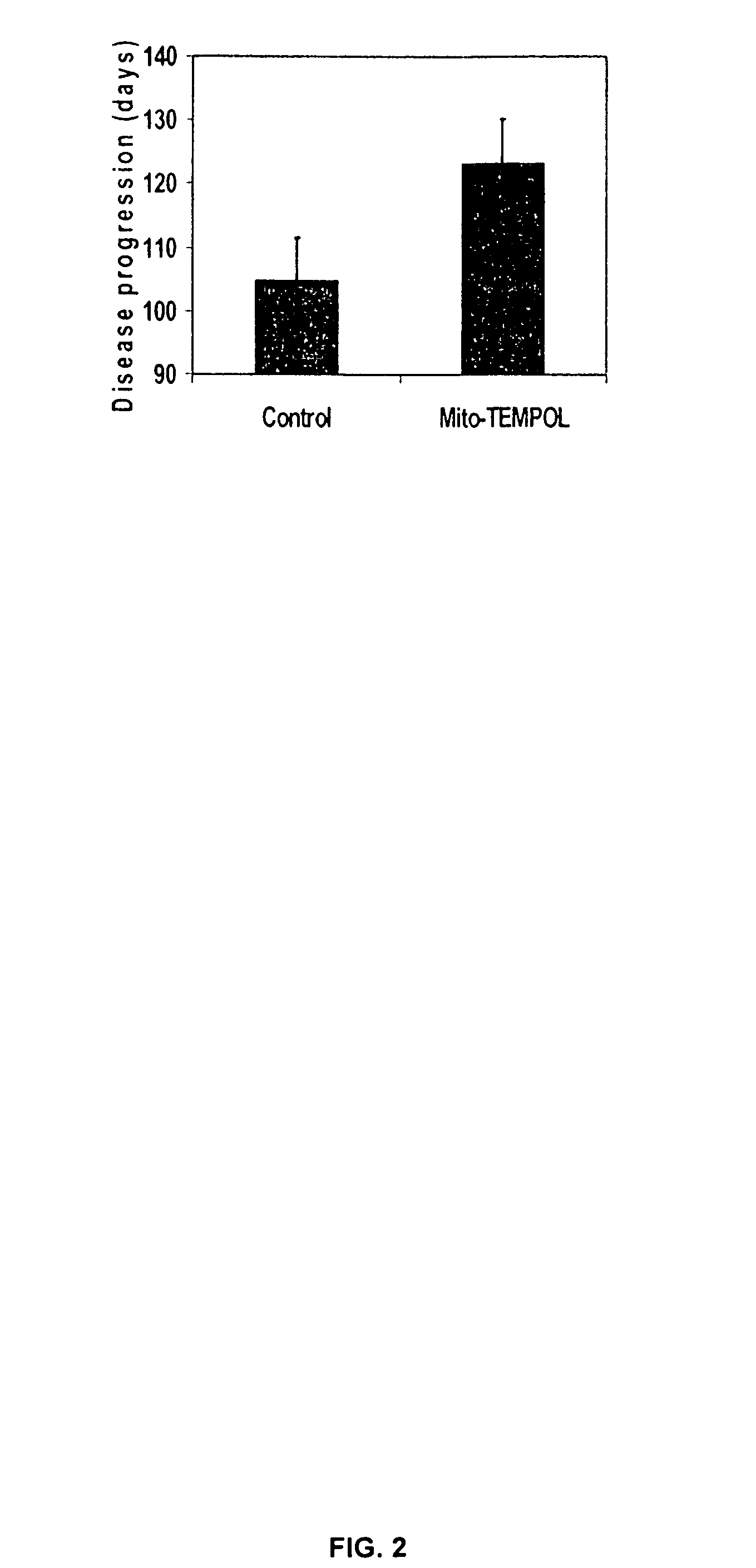Neuroprotection by positively-charged nitroxides
a positively charged, neutron-charged technology, applied in the direction of biocide, animal husbandry, organic active ingredients, etc., can solve the problems of mitochondrial dysfunction, mitochondrial dysfunction and cell death in many neurodegenerative disorders, and ros-scavenging system failure or overwhelmed
- Summary
- Abstract
- Description
- Claims
- Application Information
AI Technical Summary
Benefits of technology
Problems solved by technology
Method used
Image
Examples
example 1
Synthesis of Mito-Tempol
[0050] Methods: Previous investigators (Dessolin et al., supra) used a large excess of a reductant (sodium hydride) during their attempted synthesis of Mito-Tempol. In addition, they used dimethylformamide as a solvent. This particular solvent is typically not used for nitroxide ether synthesis. However, we discovered two differences that led to an increased production of Mito-Tempol. A first difference in our method of synthesizing Mito-Tempol is that we used a stoichiometric amount of sodium hydride (i.e., the ratio of Tempol to sodium hydride is nearly 1:1). A suitable range is 1:1 to 1:2. A second difference in our method of synthesizing Mito-Tempol is that we used benzene as a solvent. One can also use other solvents, such as dioxane, toluene or heptane. We believe that these two differences are instrumental for our successful synthesis of Mito-Tempol.
[0051] Mito-Tempol was synthesized as follows (shown in Table 2): Tempol (3.44 g. or 20 mmole; Sigma-A...
example 2
In Vivo Attenuation of ALS Symptoms
[0056] Methods: Mito-Tempol was prepared as described above.
[0057] Animal model: A transgenic mouse line overexpressing mutant G93A-SOD1 gene (TgN(SOD1-G93A)1Gur, herein called hSOD1-G93A, a high expression mouse line) and the mating pairs were purchased from Jackson Laboratory (Bar Harbor, Me.). Mice were housed and bred as described previously (Liu R, et al., “Enhanced oxygen radical production in a transgenic mouse model of familial amyotrophic lateral sclerosis,” Ann. Neurol. 44:763-70 (1998)) and in accordance with the University of North Dakota Animal Care and Use Committee guidelines.
[0058] At age 40-50 days, transgenic littermates (wild-type normal mice and hSOD1-G93A mice) were divided into three groups (n=10) and administered with vehicle alone (regular drinking water), Mito-Tempol (40 mg / kg or about 1 mg / mouse / day) or Tempol (40 mg / kg or about 1 mg / mouse / day), respectively. The onset of disease was defined as the day when a sharp decr...
example 3
Comparison of Mito-Tempol and Tempol
[0061] Methods: Mito-Tempol was prepared as described above.
[0062] Cell line: Bovine aortic endothelial cells (BAECs; American Type Culture Collection) were grown to confluence in DMEM (Calbiochem; San Diego, Calif.) containing 10% fetal bovine serum (FBS; Invitrogen; Carlsbad, Calif.) insulin (10 μg / ml; Invitrogen), transferrin (5 μg / ml; Invitrogen), glutamine (4 mM; Sigma-Aldrich), penicillin (100 units / ml; Sigma-Aldrich) and streptomycin (100 μg / ml; Sigma-Aldrich) and were incubated at 37° C. in a humidified atmosphere of 5% CO2 and 95% air. The BAECs were used between passages four and twelve, as described by Balla G, et al., “Ferritin: a cytoprotective antioxidant strategem of endothelium,” J. Biol. Chem. 267:18148-18153 (1992). On the day of treatment, the medium was replaced with DMEM containing 2% FBS.
[0063] Glucose / Glucose Oxidase (Glu / GO): GO was obtained from Sigma Aldrich (Milwaukee, Wis.); 13-hydroperoxyoctadecadienoic acid (13-HpO...
PUM
| Property | Measurement | Unit |
|---|---|---|
| emission wavelengths | aaaaa | aaaaa |
| emission wavelengths | aaaaa | aaaaa |
| body weight | aaaaa | aaaaa |
Abstract
Description
Claims
Application Information
 Login to View More
Login to View More - R&D
- Intellectual Property
- Life Sciences
- Materials
- Tech Scout
- Unparalleled Data Quality
- Higher Quality Content
- 60% Fewer Hallucinations
Browse by: Latest US Patents, China's latest patents, Technical Efficacy Thesaurus, Application Domain, Technology Topic, Popular Technical Reports.
© 2025 PatSnap. All rights reserved.Legal|Privacy policy|Modern Slavery Act Transparency Statement|Sitemap|About US| Contact US: help@patsnap.com



